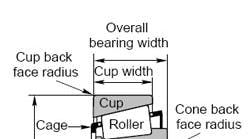Tapered roller bearings
A major type of rolling-element bearing is the tapered roller bearing. It is at once versatile and complex in its many forms. And its proper application and use give rise to many questions for which you must have the right answers — questions we’ll discuss here and in future columns.
Q: When we replace spacer bearings, we simply reorder according to the original bearing part number. No problem, right?
A: Of course this is the correct practice with most bearings, but with spacer bearings, it’s not quite that easy. A spacer is used with a bearing to provide just the right amount of end play for a specific bearing location in a specific machine. This required end play is determined by the bearing manufacturer’s application engineers by considering factors such as speed, load, lubrication, and temperature. The spacer is then ground to get the desired setting for that particular bearing and application. Because it is tailormade for a specific application, a spacer cannot be used with any other bearing even though that bearing may carry the same part numbers.
So, when ordering a replacement spacer bearing, it is not enough to order by component part numbers alone. You must order a complete matched assembly. This assembly will contain the same cone (inner ring) and cup (outer ring) part numbers, and a spacer ring that has been matched to the components and ground to a measurement that provides the correct bench end play for the assembly. Usually, the spacer ring has the part number and end play etched on its side. (With some assemblies the spacer may not be marked.) If you don’t know the assembly number, you must provide all component numbers and end play.
If you follow these guidelines, you will always be sure of maintaining the exact, originally specified setting for that applications when replacing bearings.
Q:When replacing a tapered roller bearing, I’ve noticed a small dot etched on both the cup and the cone. What’s their significance?
A: The small etched dots indicate the point of maximum radial runout of both the cup (outer ring) and cone (inner ring) of precision tapered roller bearings. When replacing bearings in a precision application — such as on a machine-tool spindle — it is important not only to use replacement bearings with the same class of precision as the originals, but also to mount them correctly.
For maximum precision, the bearing cup should be installed with its dot 180 deg from the point of maximum runout (high point) of the housing bore. Similarly, the cone of the bearing should be mounted with its dot 180 deg from the shaft, or spindle, high point.
Subsequently. all cups should be mounted in the housing with their dots aligned. Similarily, all cones on the spindle should be mounted with their dots aligned.
By mounting each bearing cup in its housing and each cone on its spindle in this way, their runouts tend to cancel each other and neutralize the effects of eccentricity and high spots which exist, to some degree, in all components.
Next: More about tapered roller bearings.
